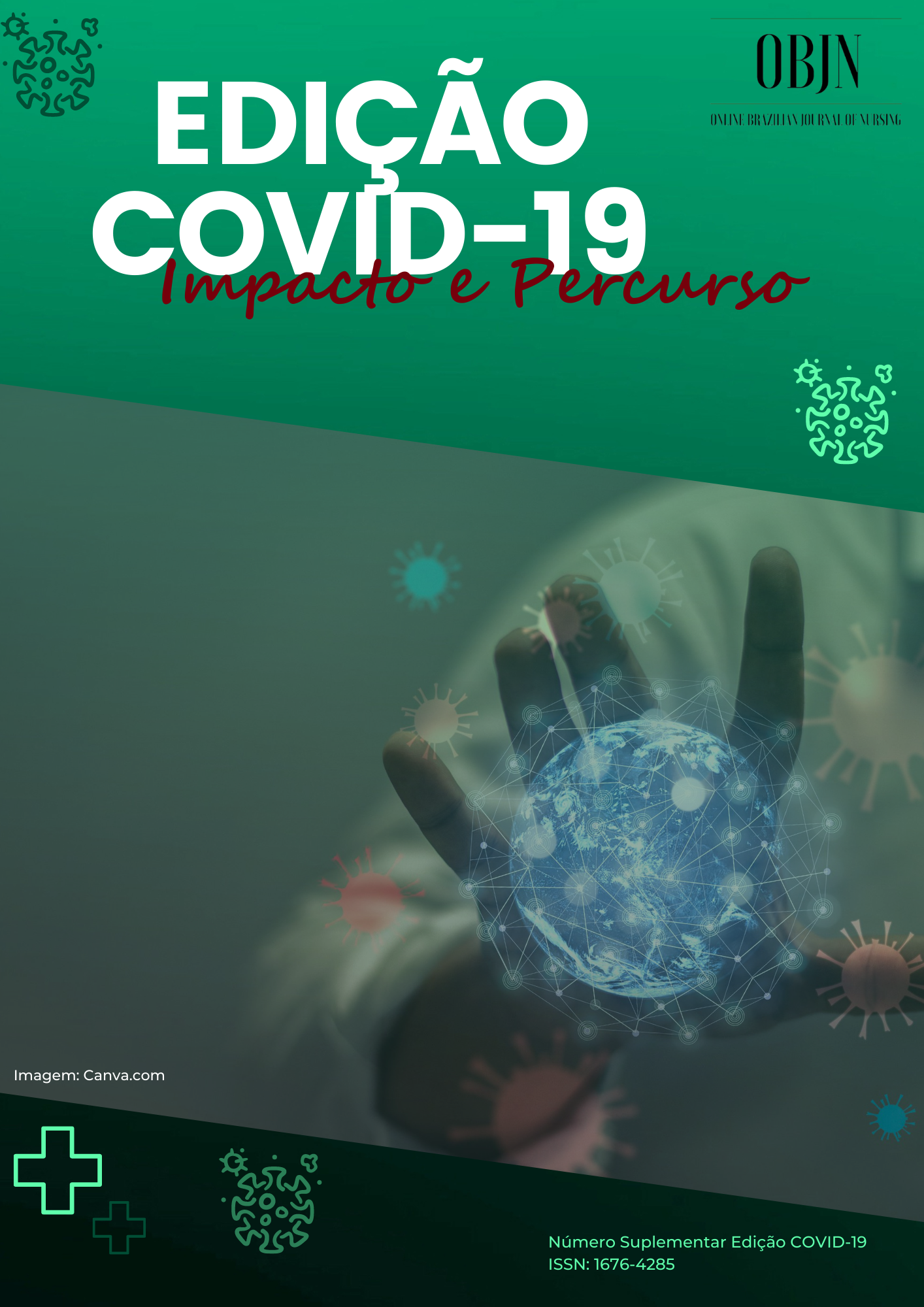Resumen
Objetivo: Describir las estrategias que se desarrollaron en los hospitales universitarios para enfrentar la pandemia de COVID-19. Método: Investigación descriptiva, con enfoque cuantitativo y cualitativo, desarrollada a partir de survey online con 104 enfermeros de tres hospitales universitarios brasileños. El procesamiento de datos se realizó mediante análisis textual con la ayuda del software IRAMUTEQ®. Resultados: Se obtuvieron seis clases semánticas que representan las principales estrategias desarrolladas para enfrentar la pandemia de COVID-19 en el ámbito hospitalario: 1) Suministro de Equipos de Protección Personal (17,2%); 2) Capacitación del equipo para la atención (18,8%); 3) Entrenamiento del equipo de apoyo (15,6%); 4) Adquisición de equipos de buena calidad (14,1%); 5) Definición de flujos institucionales (20,5%) y 6) Promoción de apoyo psicológico (14,1%). Conclusión: Las estrategias enumeradas por los enfermeros han contribuido a la calidad de la atención que se les prestó a los pacientes y a mantener la salud de los trabajadores.
Citas
Deng SQ, Peng HJ. Characteristics of public health responses to the Coronavirus disease 2019 outbreak in China. J Clin Med. 2020;9(2):575. http://dx.doi.org/10.3390/jcm9020575. Pmid:32093211.
Rodriguez-Morales AJ, Gallego V, Escalera-Antezana JP, Méndez CA, Zambrano LI, Franco-Paredes C, et al. COVID-19 in Latin America: the implications of the first confirmed case in Brazil. Travel Med Infect Dis. 2020;35:101613. http://dx.doi.org/10.1016/j.tmaid.2020.101613. Pmid:32126292.
Center for Systems Science and Engineering. Johns Hopkins University. Modeling the spread of 2019‐nCoV [Internet]. 2020 [cited 2021 Aug 10]. Available from: https://systems.jhu.edu/wp‐content/uploads/2020/01/Gardner‐JHU_nCoV‐Modeling‐Report_Jan‐26.pdf
Belarmino AC, Rodrigues MEG, Anjos SJSB, Ferreira AR Jr. Collaborative practices from health care teams to face the covid-19 pandemic. Rev Bras Enferm. 2020;73(2, Suppl 2):e20200470. http://dx.doi.org/10.1590/0034-7167-2020-0470. PMid:33111780.
Bitencourt JVOV, Meschial WC, Frizon G, Biffi P, Souza JB, Maestri E. Nurse’s protagonism in structuring and managing a specific unit for COVID-19. Texto Contexto Enferm. 2020;29:e20200213. http://dx.doi.org/10.1590/1980-265x-tce-2020-0213.
Gastaldo D, Vieira AC. From Discredited to Heroines: COVID-19 and the year that would be Nursing Now. Esc Anna Nery. 2020;24:e20200409. http://dx.doi.org/10.1590/2177-9465-ean-2020-0409.
Nasi C, Marcheti PM, Oliveira E, Rezio LA, Zerbetto SR, Queiroz AM, et al. Meanings of nursing professionals’ experiences in the context of the pandemic of COVID-19. Rev Rene. 2021;22:e67933. http://dx.doi.org/10.15253/2175-6783.20212267933.
Costa ICP, Sampaio RS, Souza FAC, Dias TKC, Costa BHS, Chaves ECL. Scientific production in online journals about the new coronavirus (covid-19): bibliometric research. Texto Contexto Enferm. 2020;29:e20200235. http://dx.doi.org/10.1590/1980-265x-tce-2020-0235.
Menon V, Muraleedharan A. Internet‐based surveys: relevance, methodological considerations and troubleshooting strategies. Gen Psychiatry. 2020;33(5):e100264. http://dx.doi.org/10.1136/gpsych-2020-100264. PMid:32818170.
Coelho MMF, Cavalcante VMV, Cabral RL, Oliveira RM, Araújo MÂM, Gomes AMT. Structural analysis of the social representations on covid-19 among assistance nurses. Texto Contexto Enferm. 2021;30:e20200358. http://dx.doi.org/10.1590/1980-265x-tce-2020-0358.
Shanafelt T, Ripp J, Trockel M. Understanding and addressing sources of anxiety among health care professionals during the COVID-19 pandemic. JAMA. 2020;323(21):2133-4. http://dx.doi.org/10.1001/jama.2020.5893. PMid:32259193.
Gallasch CH, Cunha ML, Pereira LAS, Silva-Junior JS. Prevention related to the occupational exposure of health professionals workers in the COVID-19 scenario. Revenferm UERJ. 2020;28:e49596. http://dx.doi.org/10.12957/reuerj.2020.49596.
Sperling D. Ethical dilemmas, perceived risk, and motivation among nurses during the COVID-19 pandemic. Nurs Ethics. 2021;28(1):9-22. http://dx.doi.org/10.1177/0969733020956376. PMid:33000673.
Rios AFM, Lira LSSP, Reis LM, Silva GA. Primary health care in front of covid-19: experience report from a health center. Enferm Foco. 2020;11(1):357-707X. [cited 2021 Aug 10]. Available from: http://revista.cofen.gov.br/index.php/enfermagem/article/view/3666/836
Santos RS, Barreto CTG, Lemos PFS, Duarte CA, Moreira DS, Reis AT, et al. Management of a university ambulatory service: nursing in coping with the pandemic of COVID-19. Rev Bras Enferm. 2021;74(74, Suppl 1):e20200834. http://dx.doi.org/10.1590/0034-7167-2020-0834. PMid:33886842.
Oliveira AFC, Teixeira EA, Athanázio SR, Soares RS. Psychic suffering and psychodynamics in the nurse’s work environment: an integrative review. Online Braz J Nurs. 2020;9(1):1-9. http://dx.doi.org/10.17665/1676-4285.20165167.
Arroyo-Laguna J. Redistribution of salary or professional recognition? The difficult construction of a profession, the Peruvian nursing. Cien Saude Coletiva. 2020;25(1):223-32. http://dx.doi.org/10.1590/1413-81232020251.25972019. PMid:31859870.
Shahrour G, Dardas LA. Acute stress disorder, coping self-efficacy and subsequent psychological distress among nurses amid COVID-19. J Nurs Manag. 2020;28(7):1686-95. http://dx.doi.org/10.1111/jonm.13124. PMid:32767827.
Lai J, Ma S, Wang Y, Cai Z, Hu J, Wei N, et al. Factors associated with mental health outcomes among health care workers exposed to coronavirus disease 2019. JAMA Netw Open. 2020;3(3):e203976. PMid:32202646.
Sarti TD, Lazarini WS, Fontenelle LF, Almeida APSC. What is the role of Primary Health Care in the COVID-19 pandemic? Epidemiol Serv Saude. 2020;29(2):e2020166. PMid:32348404.

Esta obra está bajo una licencia internacional Creative Commons Atribución 4.0.
Derechos de autor 2022 Array

